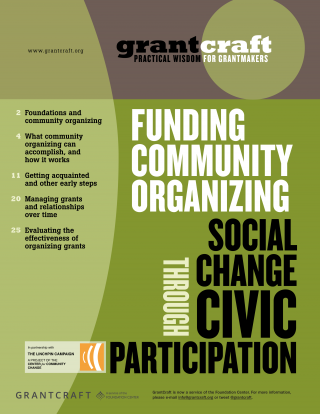Funding Community Organizing Social Change Through Civic Participation
Grantmakers who fund community organizing say it's the best option when you want to promote civic engagement and support lasting solutions to a community's problems. Yet many funders, concerned about the ability to measure its impact and effectiveness, hesitate to take up community organizing as a strategy. In this guide, funders and organizers discuss what makes community organizing unique and uniquely effective, how to manage grantee relationships over time, understanding the value of process, and the grantmaker's special role in fostering change.
Highlights
- The benefits and methods of community organizing
- Points of entry for grantmakers
- Mapping resources and power
- When a grantee is under attack
What's in the Guide?
- Foundations and Community Organizing: Some funders see community organizing as a way to encourage a more vibrant democracy; others see it as a method for getting better, more durable solutions to deep-seated problems. For grantmakers in either camp - along with those who hold both points of view - funding community organizing can be a good choice.
- What Community Organizing Can Accomplish:These days, organizing uses a mix of tried-and-true methods and new techniques to bring people together and push for change. For grantmakers, the alignment between what community organizing seeks to accomplish and how it accomplishes those things makes it an attractive strategy - one that holds the promise of leaving communities stronger and individuals better able to advocate for themselves.
- Getting Acquainted and Other Early Steps:The culture of organizing may seem foreign at first to grantmakers, trustees, and other people inside your foundation. Likewise, the culture of philanthropy may seem strange to people who see the field from the perspective of community organizing. Grantmakers commonly find themselves in the role of translator, clarifying expectations and opening up avenues of communication in both directions - with grantees and inside the foundation.
- Managing Grants and Relationships Over Time: Change is a constant in community organizing, and it doesn't stop once the grant is made. Priorities and tactics evolve as the work goes forward and the surrounding environment shifts. As time goes on, grantmakers may see the need to help an organizing grantee build its capacity or, in rare instances, cope with a crisis or setback.
- Evaluating the Effectiveness of Organizing Grants: Good organizing produces outcomes, and those outcomes can be measured. Policies change, communities change, organizations change, and people change. If funders are clear about the outcomes they're after, any or all of those may be relevant.

Categories
Content type
Strategies
-
Link to Organize: New Routes to Community Health
Capacity Building for Community Organizing Grants
“Organizational development is the biggest need” in community organizing, argued a grantmaker at a national foundation, “and a challenge philanthropy ought to do more to take up. There’s a field-building side to this.”
Read more -
Link to Organize: New Routes to Community Health
Resources for Funding Community Organizing
A lot has been produced about organizing in the past few years: books, case studies, research reports, toolkits, web-based materials, films, and more. As we developed this guide, grantmakers recommended some excellent resources, compiled below.
Read more -
Link to Organize: New Routes to Community Health
Learning from Site Visits
A site visit is often the best and more reliable way to learn about organizing and how a particular organizing group operates. Grantmakers use site visits to get to know a group initially, help board members and colleagues understand the work firsthand, and keep in touch with progress over time.
Read more -
Link to Organize: New Routes to Community Health
The Impact of Organizing Where Do You See It?
Community organizing has visible outcomes, grantmakers said, if the funder and the grantee look in the right places and ask the right questions.
Read more -
Link to Organize: New Routes to Community Health
Tandem Tactics Strategies that Complement Organizing
Service delivery. Some successful organizing groups offer services such as legal assistance, housing aid, citizenship and English as a second language classes, or job placement.
Read more -
Link to Organize: New Routes to Community Health
When a Community Organizing Organization is Under Attack
- Make sure grantees know that you strongly prefer to hear bad news from them first. (This requires a basis of trust, grantmakers said, that needs to be established from the start.)
-
Link to Organize: New Routes to Community Health
Organizational Development
Organizational development is the biggest need in community organizing, argued a grantmaker at a national foundation, and a challenge philanthropy ought to do more to take up.
Read more -
Link to Organize: New Routes to Community Health
The Grantmaker’s Role in Community Organizing
- Advocate - Make the case for supporting a grantee or a line of work
- Bridge builder - Make it possible for strange or unlikely partners to work together
-
Link to Organize: New Routes to Community Health
Getting Acquainted to Community Organizing Grantmaking
Establishing Relationships
Grantseekers and grantees from organizing groups are often very deliberate about establishing relationships with program officers, sharing information about their own backgrounds and encouraging funders to do the same.
Read more -
Link to Organize: New Routes to Community Health
Methods of Community Organizing
- Issue development by the people most affected. As one former program officer described, “It is the problems of importance to people that bring them out of their living rooms and into the meeting rooms of broader civic life: making those improvements is the motivating factor.”
Grantmakers who fund community organizing say it's the best option when you want to promote civic engagement and support lasting solutions to a community's problems. Yet many funders, concerned about the ability to measure its impact and effectiveness, hesitate to take up community organizing as a strategy. In this guide, funders and organizers discuss what makes community organizing unique and uniquely effective, how to manage grantee relationships over time, understanding the value of process, and the grantmaker's special role in fostering change.
Highlights
- The benefits and methods of community organizing
- Points of entry for grantmakers
- Mapping resources and power
- When a grantee is under attack
What's in the Guide?
- Foundations and Community Organizing: Some funders see community organizing as a way to encourage a more vibrant democracy; others see it as a method for getting better, more durable solutions to deep-seated problems. For grantmakers in either camp - along with those who hold both points of view - funding community organizing can be a good choice.
- What Community Organizing Can Accomplish:These days, organizing uses a mix of tried-and-true methods and new techniques to bring people together and push for change. For grantmakers, the alignment between what community organizing seeks to accomplish and how it accomplishes those things makes it an attractive strategy - one that holds the promise of leaving communities stronger and individuals better able to advocate for themselves.
- Getting Acquainted and Other Early Steps:The culture of organizing may seem foreign at first to grantmakers, trustees, and other people inside your foundation. Likewise, the culture of philanthropy may seem strange to people who see the field from the perspective of community organizing. Grantmakers commonly find themselves in the role of translator, clarifying expectations and opening up avenues of communication in both directions - with grantees and inside the foundation.
- Managing Grants and Relationships Over Time: Change is a constant in community organizing, and it doesn't stop once the grant is made. Priorities and tactics evolve as the work goes forward and the surrounding environment shifts. As time goes on, grantmakers may see the need to help an organizing grantee build its capacity or, in rare instances, cope with a crisis or setback.
- Evaluating the Effectiveness of Organizing Grants: Good organizing produces outcomes, and those outcomes can be measured. Policies change, communities change, organizations change, and people change. If funders are clear about the outcomes they're after, any or all of those may be relevant.



